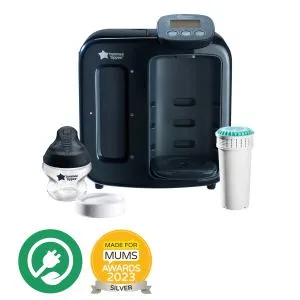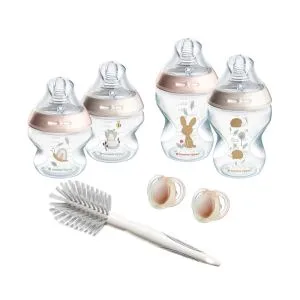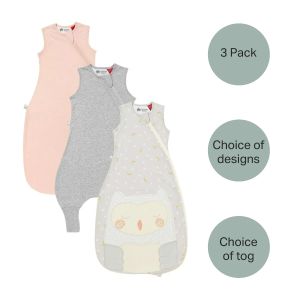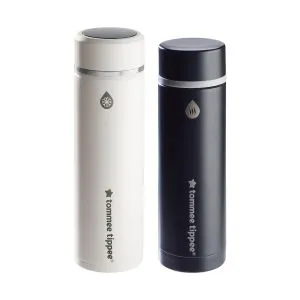
Tommee Tipps
Baby-led weaning offers a popular alternative to puree feeding for many parents. Lots of mums and dads find that it helps their little one to learn new skills and allows them to enjoy exploring new flavours.
A Guide to Baby-Led Weaning
In the UK, three in five first-time parents find weaning confusing and, almost two-thirds have heard conflicting advice about when to introduce solid foods. The truth is, every baby has a unique weaning journey.
Baby-led weaning offers a popular alternative to puree feeding for many parents. Lots of mums and dads find that it helps their little one to learn new skills and allows them to enjoy exploring new flavours.
Let's run through the details of baby-led weaning and answer some of the most frequently asked questions on the topic. That way, you can decide if it’s the right weaning method for you and your baby.
What is baby-led weaning?
Baby-led weaning (BLW) means letting your child eat independently. First, they will use their hands, then move on to using cutlery. The term was created in 2001 by Gill Rapley, and describes a relaxed and unstructured approach where babies are offered solid foods and feed themselves. The food is usually served in small, soft pieces that can be held in the baby's hand, rather than being offered as puréed on a spoon.
We know that choosing a weaning style can feel daunting, so read on to learn all about the benefits of baby-led weaning, when to start, and what kind of foods you can offer at every stage.
The benefits of baby-led weaning
Yes, it can be a little messier than traditional weaning, but there are tons of pros when it comes to baby-led weaning! These include:
- Improved fine motor, chewing, and hand-eye coordination skills.
- It’s easier to prepare meals, as baby can eat the same foods as the whole family.
- Your little one gets a full sensory experience and develops good eating habits as they explore, inspect, and taste different flavours and textures.
- They develop independence because they’re in control. They’ll also recognise when they’re full and when to stop eating.
- Making homemade baby foodlets you be sure of exactly what’s gone into your little one’s meal.
- It makes picky eatingand mealtime battles less likely.
- Baby-led weaning teaches your little one to recognise when they’re full and regulate how much they eat, meaning it could potentially lower the risk of childhood obesity.
When to start baby-led weaning
Weaning typically starts at around six months, but it's important to look out for certain cues that will let you know if your baby is ready or not. These include:
- Staying in a sitting position and holding their head steady.
- Coordinating their eyes, hands, and mouth so they're able to look at food, pick it up, and put it in their mouth.
- Swallowing food (rather than spitting or pushing it out).
- Making mouthing movements as they watch others eat and showing an interest in food.
How to start baby-led weaning
Instead of spoon-feeding, baby-led weaning involves setting out soft finger foods in front of your little one on a table or highchair tray and letting them take control!
To help you get started, here are our top tips for baby-led weaning success:
- Continue to offer breast milk or formula feeds when weaning. Breast milk or formula should be their main drink for the first 12 months. This is where most of your baby's nutrition and hydration will come from as you begin introducing them to solid foods. It’s a good idea to give them these feeds after they’ve eaten solid foods because their tummy will fill up quickly.
- Offer water in small amounts during mealtimes from the age of six months. Water can be served in an open cup from six months old to help baby develop their oral motor skills.
- Introduce one new food each day for your baby to explore. This way, they have a variety of foods and discover more options they enjoy. It also means you can see what kind of foods or shapes they prefer.
- Lay a wipe-clean tablecloth under the highchair to catch any mess. At first, you may find that your baby creates a real mess during mealtimes. But that’s all part of the process.
- Offer your baby food, rather than giving it to them. Put it in front of them or let them take it from your hand so that the decision is theirs.
- Involve your baby in your mealtimes. If it’s suitable, you can give them the same meal that you're eating in a smaller portion. This will help them learn to copy you. Just remember to avoid adding extra salt or sugar to your baby’s food.
- Schedule mealtimes for when your baby isn't tired or too hungry. That way, they can concentrate on learning new skills.
- Many babies eat only small amounts for the first few months of baby-led weaning. For them, these early mealtimes are about discovering and learning rather than eating. You'll know when your baby is finished eating if they turn their head away and shut their mouth. If they show these signs, don’t keep feeding them and trust their cues. They'll let you know when they're feeling peckish again!
- Keep smiling, enjoying, and paying attention. If you keep it enjoyable, your baby will be keen to try new foods and look forward to mealtimes. Weaning is a very short time in your child's life, so have a camera ready to capture their first gummy, carroty smiles!
How to do baby-led weaning safely
When they're first getting started, lots of parents wonder "is baby-led weaning dangerous?". One recent study found there's no increased choking risk for babies who feed themselves solid food compared to spoon-fed babies. Therefore, baby-led weaning is no more dangerous.
Often, babies are not choking when they eat but gagging. Gagging may look similar to choking and can be scary, but they're entirely different. So, it can help to know what to look out for.
Gagging is caused by your baby’s gag reflex. This is natural safety mechanism we have to help prevent choking. Your little one may also gag on foods they're trying for the first time. This is because their taste buds aren’t yet used to these new flavours and textures.
Gagging is sometimes mistaken for choking. But don’t worry, gagging is a perfectly normal part of tasting new foods. If your baby is gagging, don’t try to help them or prevent them from being sick, because this can cause them to choke.
Signs of gagging can include…
- Loudly gurgling, coughing, or sputtering
- Regurgitating swallowed food back into their mouth, spitting up or vomiting
- Baby thrusting their tongue forward
- Baby's face turning red.
It's always important for parents to know the signs of choking, too. These include…
- Having difficulty breathing or coughing
- Having a terrified expression on their face
- Making high-pitched noises while breathing
- Face and lips that turn blue
- Struggling to make a sound.
To keep your little one safe while weaning…
- Sit them upright, facing the table, either on your lap or in a highchair. Make sure they can sit steadily and can use their hands and arms freely.
- Never leave them alone with food and always monitor them at mealtimes.
- Talk to your health advisers if your family has a history of food intolerance, digestive issues, allergies, or any other concerns about your baby’s health or development.
- Some parents worry about their baby's nutrient and energy intake when baby-led weaning. However, numerous studies show that babies take in enough energy with this weaning approach.
First foods for baby-led weaning
All foods you give should be soft enough to be mashed with your baby's tongue or between your fingers.
The foods offered can include toast batons, carrot sticks, broccoli, chicken, salmon – whatever they're able to hold, squash and sensibly chew, or gum! That’s the essence of it.
The sticks or strips of food given to babies should be twice the length of their hand so they can grasp them with their whole fist.
It's also important to note that babies don't need salt or sugar added to their food. This can be bad for their teeth and kidneys. If you're giving your child the same meal as the rest of the family, serve out their portion before adding seasoning.
| Baby's First Vegetables | Baby’s Age | How to Serve |
| Asparagus, avocado, broccoli, butternut squash, cabbage, carrots, cauliflower, courgette, green beans, kale, parsnips, peas, peppers, spinach, and swede. | 6 Months | It’s a good idea to offer a variety of vegetables from the get-go. They should be cooked until very soft, then mashed or blended into a suitable texture. Alternatively, they can be sliced up and offered as baton-shaped finger foods that can be squashed between your finger and thumb. |
| 7 – 9 Months | Cook vegetables to soften them, then mash them to a lumpy texture or chop them into finger foods. | |
| 10 – 12 Months | By now, your little one should be able to eat mashed, lumpy, chopped and finger foods. Veggies should be cooked until soft and offered chopped or as hand-held finger foods. | |
| 12 Months+ |
| Baby's First Fruits | Baby’s Age | How to Serve |
| Apples, bananas, blueberries, kiwi, mango, melon, nectarines, oranges, papaya, peach, pears, pineapple, plums, raspberries, and strawberries. | 6 Months+ | At any stage, you can soften (either blend or mash) ripe fruits to the perfect texture for your baby or chop them up and offer them as baton-shaped finger foods. Please note that fruits that are a little firmer need to be cooked until soft. You should always wash fruit and get rid of pips, stones, and hard skin before offering it to your baby. |
| Baby's First Proteins | Baby’s Age | How to Serve |
| Beans, beef, chicken, eggs, fish with no bones, lamb, lentils, pork, pulses like chickpeas, tofu, and turkey. | 6 Months+ | This food group is suitable for babies from around six months of age, provides protein and contains other nutrients like iron and zinc. When preparing eggs for your baby, make sure they’ve got a British Lion Quality stamp. |
| Baby's First Dairy Foods | Baby’s Age | How to Serve |
| Dairy products like cheese and yoghurt. | 6 Months+ | You can offer your baby pasteurised dairy foods as part of a meal from around six months. Plain yoghurts that are full-fat and unsweetened are best. Full-fat goat’s, sheep’s or cows' milk that’s pasteurised can be used when cooking for your baby from around six months old. However, these shouldn’t be offered as drinks until they’re one years old or over. |
| First Starchy Foods | Baby’s Age | How to Serve |
| Bread, pasta, porridge oats, potato, quinoa, rice, sweet potato, and toast. | 6 Months+ | These foods can be cooked if needed, and then mashed or blended to a suitable texture for your baby. Alternatively, they can be chopped and offered as finger foods. |
Baby weaning schedule
There's no set amount of food that babies should eat during the baby-led weaning process.
The idea of this method of weaning is that it’s led by your baby, and they'll tell you when they’ve had enough. Plus, since they're still having breast milk or formula until they're at least a year old, they'll continue to get all the calories they need.
BLW foods by age
If you're baby-led weaning, your baby's first foods should be firm enough for them to grasp but soft enough for the baby to gum without irritation or difficulty. Then, as they get older and their confidence and motor skills develop, they can expand their palette of flavours and textures.
Here are some of the most popular baby-led weaning foods that parents introduce their baby to at different ages.
BLW foods: 6 months
- Soft, mashed, or blended vegetables and fruits, such as broccoli, carrot, sweet potato, parsnip, apple, and pear.
- Baby rice mixed with breast milk or formula.
- Toast strips.
- Unflavoured Greek yoghurt.
- Soft cheese like ricotta or mozzarella.
- Steamed strips of tofu.
- Unflavoured pureed meat, like chicken, turkey, or beef, that's shaped into sticks or strips.
- Very small amounts of foods that may trigger an allergic reaction (these should be introduced one at a time). These can include cow’s milk that has been mixed with food, cooked eggs with a Red Lion stamp, crushed nuts and seeds, soya, cooked shellfish, and fish.
BLW foods: 7-9 months
As well as the foods listed above, from seven months you can introduce…
- Thinly sliced or halved fruits, like strawberries, blueberries, and raspberries.
- Harder cheese, like Swiss or cheddar, that's been cubed or grated.
- Cooked whole wheat pasta.
- Cooked pulses and beans.
- Whole grain cereal O-s.
- Minced meat and small meatballs that are cut in half.
BLW foods: 10-12 months
By the age of 10 months, babies should be having three meals a day – with lunch and tea including a main course and pudding of fruit or plain yoghurt.
Easy baby-led weaning meal ideas
Variety is the spice of life, and weaning is no different! There're tons of great websites, books, and blogs you can use for research to inspire your baby-led weaning journey. Here are a few to get you started:
Top baby-led weaning ideas and tips
Molly says "When it comes to weaning a toddler, the truth is that it gets messy! We did baby-led weaning, and my kitchen was a tip, but seeing how amazed my little boy was by food cancelled out the mess he left in the kitchen".
Sarah and Laura found that when they "began weaning, it opened up a whole new experience for us. It can get messy, but it's also really fun and exciting. We spent hours looking online and through books to find recipes, and it was amazing to introduce our little girl to new foods".
To wrap up, here are some snippets of advice to help you make baby-led weaning a success.
- Help your little one easily grip their food by using a crinkle cutter or adding ground-up whole-grain crackers or cereal to slippery food items.
- Place food items on a clean table or high-chair tray. Plates and bowls may just get in the way in the early stages of weaning.
- Take your time. Start slowly with weaning and allow your baby to set the pace and build their confidence with weaning over time.
- Minimise distractions during mealtimes.
- Set an example by showing your baby how to eat. After all, they learn by copying their parents and other children.
- Weaning can be messy, so be sure to invest in a bib to help catch any mess or spills.
Baby-led weaning FAQs
Can I combine baby-led weaning with traditional spoon-fed puree weaning?
Absolutely! Some parents love baby-led weaning and prefer it to traditional spoon feeding, while others use a bit of both.
As with most parenting topics, there isn’t one right or perfect way to wean, just what feels right for you and your baby. The main thing is that your baby has a healthy, varied diet, and gets all the important nutrients they need to grow and develop.
Purées can still be beneficial during the early baby-led weaning process. The truth is, you don't have to stop feeding purées when you begin baby-led weaning – you can mix wean! Some of the benefits of combining purées and baby-led weaning include:
- Convenience and flexibility
- Reduced food waste
- It can be easier to introduce them to new flavours and textures.
How can I incorporate pureed food into my baby-led weaning journey?
There are lots of ways you can introduce purées in your baby-led weaning routine. These include:
- Spreading fruit-based purées on toast batons.
- Loading your baby’s spoon with purée and letting them hold it and feed themselves.
- Stirring fruit-based purées into yoghurt.
- Adding purées into a pancake mix.
- Using purées as a dip for carrot or cucumber batons.
- Letting your baby explore and get messy by spreading some purée on their highchair table.
What foods can babies and toddlers not have?
While there are plenty of new tastes they can discover through baby-led weaning, there are a few foods you should steer clear of for your baby or toddler.
Along with added salt, sugar, and saturated fats, this includes honey (for babies under the age of one due to the risk of botulism), rice-based drinks (as they contain levels of arsenic), mould-ripened cheese, and certain seafood – including swordfish, shark, and marlin (as they contain mercury). Additionally, raw, or undercooked shellfish and eggs can pose a health risk.
You should also avoid giving your baby anything that poses a choking risk. This can include peanuts and whole nuts, raisins and other dried fruits, popcorn, boiled sweets, raw jelly cubes, or ice cubes.
Sources
- Impact of a modified version of baby-led weaning on iron intake and status: a randomised controlled trial - PMC (nih.gov)
- Baby-led weaning: pros and cons | Baby & toddler, Feeding articles & support | NCT
- Baby-led weaning: 10 tips to get you started | Baby & toddler, Feeding articles & support | NCT
- Your baby's first solid foods - NHS (www.nhs.uk)
- What To Feed Your Baby | Around 6 months | Weaning | Start for Life (www.nhs.uk)
- Baby-Led Weaning (BLW): Best Foods for Baby-Led Weaning & How to Start (whattoexpect.com)











